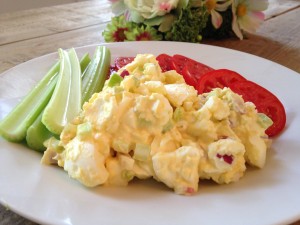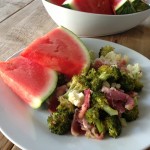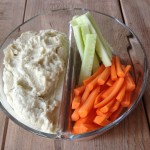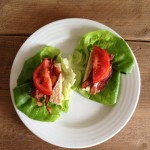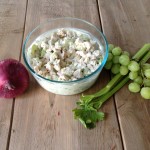This egg salad is a great quick lunch and can be made ahead of time, so you have it when you need it. My friend Linda gave us some delicious tomatoes from her father’s garden and we ate the egg salad atop the tomatoes. We also used celery sticks as dippers.
When preparing this dish it is a good idea to purchase organic celery. Celery is part of the dirty dozen and is a good one to commit to memory, because it does not fit the three main categories of foods with the highest pesticide residue (tree fruits, berries and leafy greens). USDA tests have found more than 60 different pesticides on celery. If you can’t find organic celery, safer alternatives with a similar crunch include broccoli, bok choy, radishes and onions. (Source)
Tomatoes do not rank neither among the dirtiest nor the cleanest. It is standard practice for more than 30 pesticides to be sprayed on conventionally grown tomatoes. Since the thin skin of tomatoes can allow pesticides to enter the fruit, peeling will not help rid the fruit of pesticide. Thus, it is always a good idea to buy organic when possible or grow them yourself.
One note about the lemon juice is to use fresh squeezed. Store bought lemon juice usually contains sodium benzoate.
If you decide to include eggs in your diet, a good choice is to eat Omega-3 enriched or pastured eggs. They are much more nutritious than eggs from factory-raised chickens. Historically, eggs have been considered unhealthy because they contain cholesterol. A large egg contains 212mg of cholesterol, which is a lot compared to most other foods. However, it has been proven, time and time again, that eggs and dietary cholesterol do NOT adversely affect cholesterol levels in the blood. In fact, eggs raise HDL (the good) cholesterol. They also change LDL cholesterol from small, dense LDL (which is bad) to large LDL, which is benign (1, 2, 3). A new meta-analysis published in 2013 looked at 17 prospective studies on egg consumption and health. They discovered that eggs had no association with either heart disease or stroke in otherwise healthy people. This isn’t new data. Multiple older studies have led to the same conclusion (4, 5). Further, eating eggs improves insulin sensitivity and reduces cardiovascular risk parameters (7).
A large egg contains (6): Only 77 calories, with 5 grams of fat and 6 grams of protein with all 9 essential amino acids. Eggs are also rich in iron, phosphorous, selenium and vitamins A, B12, B2 and B5 (among others). One egg contains 113 mg of Choline – a very important nutrient for the brain, among other things. (Source)
To cook the perfect eggs, use a method called “coddling”. It does not toughen the whites like boiling does. Cover the eggs with cool water, with about 1 inch extra water on top (too much extra water will take too long to bring to a boil). Add 1/2 tsp of baking soda to the water, this will make the egg shell easier to peel. (If you don’t have baking soda, vinegar works too.) Bring the pot of water just to a boil. Immediately remove the pot from the heat, cover tightly, and let stand for 17 – 20 minutes (depending on the size of the egg). Watch the time carefully. Overcooking eggs is what causes the dark ring to form between the yolk and the white. Remove the eggs from the boiling water and place them in an ice bath (bowl of water and ice) for about 10 minutes before peeling or storing. The ice bath prevents the eggs from continuing to cook due to the heat that carries over. It also creates a layer of steam between the shell and the egg white, which will make peeling easier.
If you aren’t using your eggs right away, wait to peel them. Boiled eggs can be stored for up to a week in the refrigerator. You can keep them in a bowl of cold water (if you change the water daily) or in an airtight container, without water, covered with damp paper towels.
To peel, submerge the eggs in a bowl of cool water. Cracking an egg under water helps loosen the membrane from the egg white. Under a gently running faucet, peel the egg beginning with the larger end (which is usually where the air bubble will be). Make sure you get a hold of the membrane when you’re removing the shell. (Source)
Egg Salad
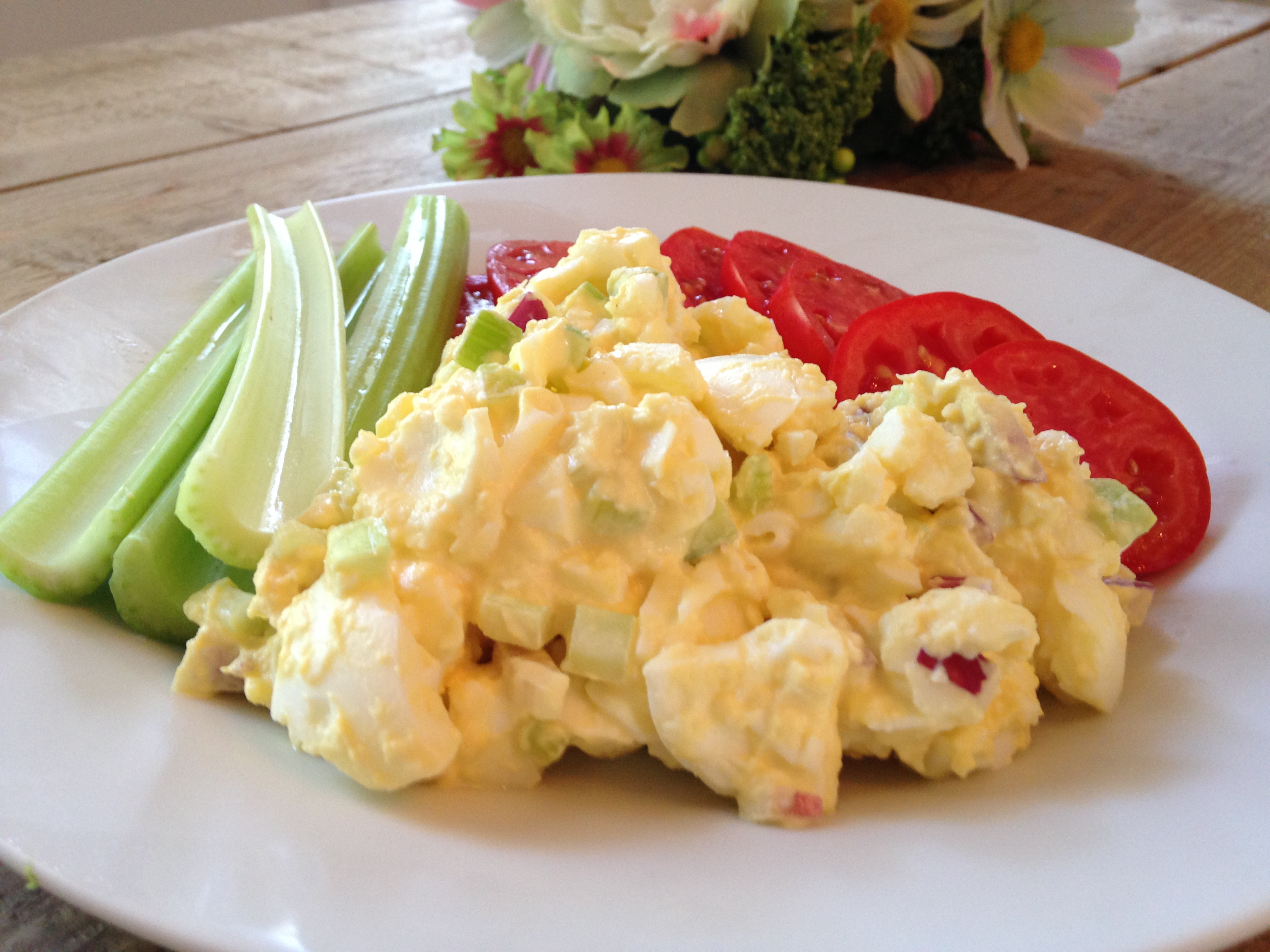
Whole Food. Real Food. Good Food. www.facebook.com/wholefoodrealfood
Ingredients
- 1/3 cup Organic Veganaise
- 1 tbsp lemon juice
- 1 tbsp Dijon mustard
- 1/4 cup chopped celery
- 1/4 cup chopped red onion
- 12 hard-boiled eggs
Instructions
- Whisk together Veganaise, Dijon mustard and lemon juice.
- Peel and chop hard-boiled eggs.
- Add eggs, onion and celery to dressing.
- Chill and serve.
- Enjoy!
Notes:
Egg Salad
1/3 cup Organic Veganaise
1 tbsp lemon juice
1 tbsp Dijon mustard
1/4 cup chopped celery
1/4 cup chopped red onion
12 hard-boiled eggs
1. Whisk together Veganaise, Dijon mustard and lemon juice.
2. Peel and chop hard-boiled eggs.
3. A dd eggs, onion and celery to dressing.
4. Chill and serve.
5. Enjoy!
To receive daily health tips and gluten-free, grain-free, dairy-free and sugar-free meal/snack ideas, like us at www.facebook.com/wholefoodrealfood.
Eat Better. Feel Better.


